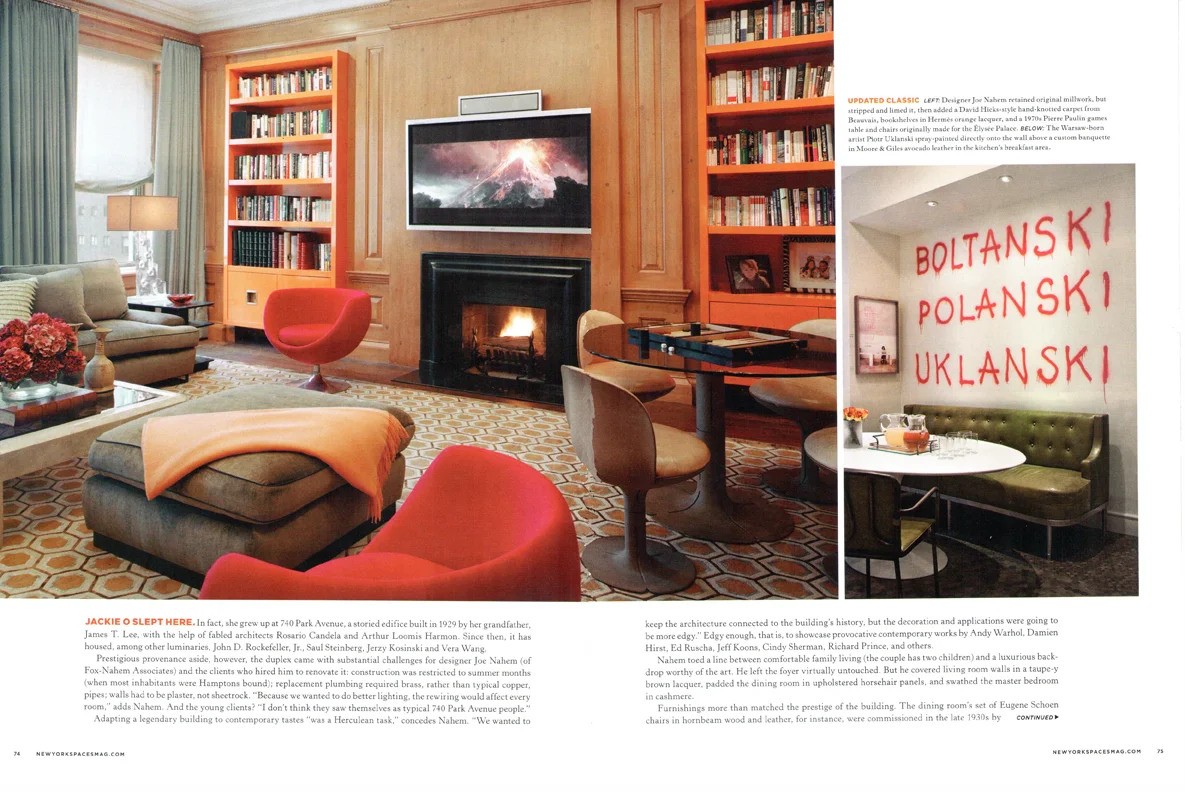NY Spaces July-Sept '15
"Mythic To Modern", written by Jorge S. Arango, Photography by Michael Moran, pages 72-79
See all photos
JACKIE O SLEPT HERE. In fact, she grew up at 740 Park Avenue, a storied edifice built in 1929 by her grandfather, James T. Lee, with the help of fabled architects Rasio Candela and Arthur Loomis Harmon. Since then, it has housed, among other luminaries, John D. Rockefeller, Jr., Saul Steinberg, Jerry Kosinski and Vera Wang.
Prestigious provenance aside, however, the duplex came with substantial challenges for designer Joe Nahem (of Fox-Nahem Associates) and the clients who hired him to renovate it: construction was restricted to summer months (when most inhabitants were Hamptons bound); replacement plumbing required brass, rather than typical copper, pipes; walls had to be plaster, not sheetrock. “Because we wanted to do better lighting, the rewiring would affect every room,” adds Nahem. And the young clients? “I don’t think they saw themselves as typical 740 Park Avenue people.”
Adapting a legendary building to contemporary tastes “was a Herculean task,” concedes Nahem. “We wanted to keep the architecture connected to the building’s history, but the decoration and applications were going to be more edgy.” Edgy enough, that is, to showcase provocative contemporary works by Andy Warhol, Damien Hirst, Ed Ruscha, Jeff Koons, Cindy Sherman, Richard Prince, and others.
Nahem toed a line between comfortable family living (the couple has three children) and a luxurious back-drop worthy of the art. He left the foyer virtually untouched. But he covered living room walls in a taupe-y brown lacquer, padded the dining room in upholstered horsehair panels, and swathed the master bedroom in cashmere.
Furnishings more than matched the prestige of the building. The dining room’s set of Eugene Schoen chairs in hornbeam wood and leather, for instance, were commissioned in the late 1930s by the powerful Washington philanthropists Gwendolyn and Morris Cafritz. Gallerist Paul Donzella had sold them to the couple for their Connecticut home before Nahem repurposed them here, pairing them with a Jacques Quinet table and custom banquettes, also in horsehair. To bring the room’s enormous size down to human scale, Nahem created an intimate seating area where a Murano chandelier illuminates a pair of Jean Royere tub chairs and an ottoman upholstered in sheared mink.
In the living room, Jules Leleu club chairs and Jacques Quinet side tables evoke styles reminiscent of 740 Park’s earlier years, while a custom ottoman with legs commissioned from French sculptor Marc Bankowsky (through Maison Gerard) is thoroughly contemporary. In the his-and-her master baths, Nahem straddled decades by creating contemporary nickel frames in which he set more de rigueur marble panels.
Livability, Nahem explains, was essential: “They wanted every room to be used,” he says, pointing out: “There’s a drop-down projector and a bar in the living room.” And when it came to the art, “We agreed it wasn’t a gallery, that the apartment should have personality.” For an apartment that already came with personality aplenty, that was a tall order. The consensus? Mission accomplished.




